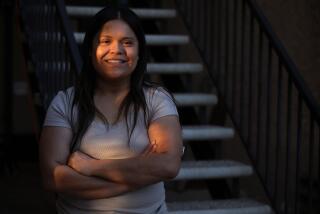The Long and Short of It
- Share via
Near the end of their 95-minute English class, Anne Kimble’s ninth-graders started to fidget. One girl doodled on her notebook. Another boy opened a novel. A few students chatted.
Kimble usually spices up her long classes at Oak Park High School with skits, debates or competitions. But on a recent day, she decided to give a lecture on how to write effective personal essays. Though she read sample stories aloud and asked for students’ opinions, several teenagers’ minds wandered before the bell rang.
Despite the difficulty of keeping students engaged, such a college-style schedule--featuring class sessions as long as two hours--is a growing trend that principals say allows for more in-depth teaching.
Oak Park is one of the schools that offer the longer classes. At the Ventura County campus each required course--social studies and English, for example--consists of 95-minute classes on alternate days. Electives are still 50 minutes.
More than 40% of California high schools have some form of this schedule, state education officials say, and more are adopting it.
So-called block scheduling gained popularity about five years ago, and the state’s forthcoming high school exit exam is breathing new life into the movement. Starting with those who are now freshmen, students will have to pass three-hour exams in English and math to receive their diplomas.
Some educators say schools with longer classes might have an advantage in getting students ready for the exit exam.
They say block scheduling gives instructors more time to teach the core subjects, reach struggling students and meet state academic standards. It also helps teachers develop closer bonds with students and individualize instruction, they maintain.
“With the high school exit exam, high schools are doing whatever it takes to get students, especially in the ninth grade, up to speed and up to grade level early,” said Pat Ainsworth, associate superintendent in the state Department of Education. “Those longer [class] periods help to facilitate that.”
Teachers say they must develop creative new lesson plans to hold students’ attention for more than an hour.
If they don’t, the classes seem to drag on forever, students complain. Brandon Koller, 14, said one of his teachers talks for nearly two hours straight. “All we do is sit in there and take notes,” he said.
On a recent day, Oak Park teacher Jeff Appell divided his 95-minute freshman math class into sections: warmup, homework review, math games, lecture, practice. “I have to mix it up,” he said. “The challenge is to keep their attention. You have to be on your toes more.”
Most California high schools have traditional six-period days with 50-minute classes, but many offer classes of 90 or 95 minutes. A survey of high schools in Ventura County revealed several variations on the schedule and different opinions about its effectiveness.
At Newbury Park High School in Thousand Oaks, students take three 90-minute classes five days a week the first term and three the next term. Nordhoff High School in Ojai has a modified block schedule, with regular classes Monday through Wednesday, and nearly two-hour classes Thursday and Friday.
Studies show that block scheduling helps improve student achievement and raises attendance rates. But not all campuses have had positive results. Hueneme High School in Oxnard, for example, abandoned its block schedule several years ago after student performance failed to improve and dropout rates increased.
Oak Park High, however, has become a model for schools across the state, with administrators frequently visiting the campus or calling for advice on how to change their schedules. Principal Cliff Moore said he believes that the approach is gaining popularity because teachers want a less frenetic school day and are trying to prepare their students for the exit exam.
Oak Park students say they enjoy having fewer courses each day and getting two nights to finish homework for each required class. They also say the schedule makes the day less stressful and less confusing. “Everything is not such a rush,” said Ellen Chen, 14. “You’re not under as much pressure.”
The block schedule boosts the amount of instructional time and cuts down on discipline problems among the school’s 930 students, Moore said. Students don’t have the hustle and bustle of several passing periods each day, and teachers only have to take attendance and collect papers every other day.
“In a traditional schedule, it takes five minutes just to get started,” Kimble said. “In a 50-minute class, that’s a lot of time.”
Moore said the longer classes are helping Oak Park students stay focused for longer than just one hour.
“The exit exam is three hours plus, and the kids need to almost be in training for that kind of extended test,” he said. “The block schedule will naturally lend itself to that.”
John Wilber, principal at Fillmore High School, doesn’t believe that adding minutes to classes is the key to raising achievement or preparing students for the upcoming exam. “It’s what teachers do when they close their doors,” he said.
Fillmore’s teachers voted against a block schedule several years ago, but some would like to revisit the topic. “We’re very concerned about preparing our students,” Wilber said, “but I’m not sure that’s the solution to the exit exam.”
More to Read
Sign up for Essential California
The most important California stories and recommendations in your inbox every morning.
You may occasionally receive promotional content from the Los Angeles Times.













